All-in-one version
Mile Marker 2022, Issue 1
Director’s Message
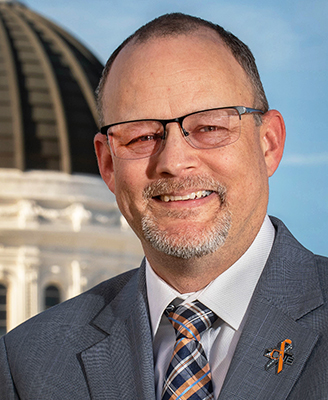
Caltrans Acting Director

Incoming Caltrans Director
My time as Caltrans’ acting Director has come to an end, and I wanted to thank you all for the support that I have received since serving in this interim role. It has been one of the great privileges of my career to help lead this outstanding organization, and I know that Tony Tavares, appointed by Gov. Gavin Newsom to be Caltrans’ new director, will provide inspiring and forward-thinking leadership at this critical time of change and opportunity in our transportation system.
I wanted to act as the sturdy bridge between Toks Omishakin, our Director before being appointed as Secretary of the California State Transportation Agency (CalSTA), and Tavares, who is poised to become Caltrans’ top executive after excelling as a Director of Caltrans’ largest regional districts and other major assignments. I also sought to affirm our organization’s commitment to the Three Foundational Principles that former director Omishakin laid out for Caltrans during his impactful tenure here: safety, equity and climate action.
With help from all of you, I think we’ve succeeded in furthering those aims.
In recent months, we have taken steps to address those foundational principles intended to improve the lives of Californians and all others who use and depend upon our state’s transportation system. We’re following through on our pledge that all new transportation projects we fund or oversee must include Complete Streets features that provide safe and accessible options for people walking, biking and taking transit. This one policy illustrates how Caltrans is committed to providing safe, convenient, sustainable and accessible alternatives to driving to achieve our climate goals while equitably serving all Californians.
The safety and reliability of our transportation system are paramount concerns. As part of the largest U.S. investment to upgrade bridges ever made, California will receive $575 million this fiscal year and an estimated $2.9 billion over five years, from the federal government to address highway bridge needs. Caltrans maintains the safety and integrity of more than 24,000 bridges owned by the state and local agencies, and these funds will be used to improve the nearly 1,500 bridges most in need of repairs throughout the state. And of note, Caltrans also is meeting its targets under SB 1 — the Road Repair and Accountability Act of 2017 — to repair or rehabilitate an additional 500 bridges through 2027.
I’m also pleased that during my time as Caltrans acting Director, we have moved to lessen or eliminate practices that contribute to climate change. As one example of that commitment, we have approved the use of low-carbon cement to help reduce the carbon footprint of our transportation system. By transitioning to the use of a particular kind of cement, Caltrans’ road construction and maintenance projects can generate less carbon dioxide — the primary greenhouse gas contributing to global warming and climate change — with the same high-performance standards at a slightly lower cost.
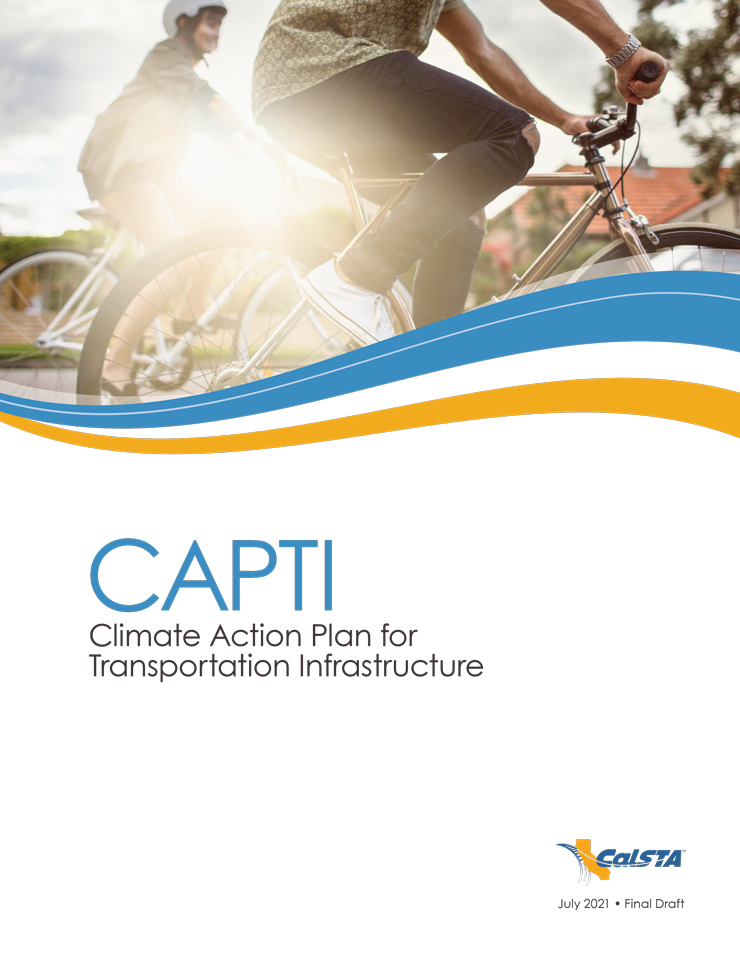
Climate Action Plan for Transportation Infrastructure (CAPTI)
On a larger climate front, Caltrans will be a strong partner to advance the California Climate Action Plan for Transportation Infrastructure, or CAPTI. Building off the California Transportation Plan 2050, the CAPTI is one of our guiding documents and establishes an investment framework, strategies and specific actions for how state agencies should invest transportation funds. For the past 18 months, we have worked in coordination with CalSTA and other state partners to develop the CAPTI, and our continued participation will be essential to its implementation.
As important as our strategies have been, it’s the human connections that I’ve found especially rewarding while in an acting director’s role. I’ve treasured working with so many people and the different talents and energy they bring toward this common purpose of improving our state’s travel network. I am grateful for your help and contributions.
There’s been the somber moments, too. It’s important we remember the fallen members of our team during events such as the Workers Memorial, and the contributions of colleagues like Quanda McGadney, who was tragically killed June 3 while doing her job along Interstate 80 in Solano County.
We have a lot to be proud of, Caltrans, and many opportunities and challenges lie ahead. I’m thankful to have contributed but a small portion to our overall success, and look forward to working with Tony Tavares as he begins his leadership of this great organization.
![]()
Mile Markers
Caltrans Key Strategic Plan Performance Measures
With the launch of the new Caltrans 2020-24 Strategic Plan, development of performance objectives is well underway. Performance objectives are intended to gauge success at affecting the intended outcomes for each of the six Goals. This dashboard represents those performance objectives in which we have begun to track and report. Additional performance objectives will be shared in coming Mile Marker issues, once data tracking and targets have been fully developed for them.
Goal: Safety First
Reduce the number of on-the-job serious injuries to zero, annually.

Through the first two quarters of fiscal year (FY) 2021-2022, 1 on-the-job serious injury has occurred as compared to four as of the same time in the prior year. An on-the-job serious injury is any work-related injury or illness resulting in a fatality, inpatient hospitalization, amputation, or loss of an eye. Work-related COVID-19 cases not counted in this performance objective.
Goal: Cultivate Excellence
Increase the percentage of surveyed external partners who positively respond to the statement, “Caltrans is a collaborative partner”, by 5% of December 31, 2021.

The External Partner Survey is an annual survey that provides Caltrans with valuable feedback on how well we performed as a partner over the past 12 months and gives insights into how we can better perform in the future.
Increase the percentage of surveyed Caltrans employees who agree or strongly agree with the statement, “I would recommend Caltrans as a great place to work to members of my community,” by 5% by December 31, 2021.

The Employee Engagement Survey is a source of critical information in support of our Cultivate Excellence Goal. It provides insight from employees that highlights the strengths of the department and identifies areas of opportunity that help the department better serve its employees and the people of California.
Goal: Enhance and Connect the Multimodal Transportation Network
Demonstrate the California Integrated Travel Program (Cal-ITP) in three regions, by 12/31/2021.

To increase the quality and quantity of transit data published by California’s transit providers, Cal-ITP and state and regional partners explored passenger-counting technologies in July 2020. Passenger occupancy data is crucial for transportation planning purposes, and physical distancing due to COVID-19 has highlighted the benefit for riders to know real-time passenger crowding in trip planning. In this quarter Caltrans added one demonstration project in the Los Angeles area, LAWA. To date, the Cal-ITP has been demonstrated in four regions throughout the state.
Goal: Strengthen Stewardship and Drive Efficiency
Increase by 100% the dollar value of contracts awarded to small businesses, disabled veteran business enterprises and disadvantaged business enterprises by June 2022.

The Office of Civil Rights is dedicated to increasing participation of Small Business, Disadvantaged Business Enterprise, and Disabled Veteran Business Enterprise firms in both Federal and State contracting. In order to achieve the goal set forth in this performance objective, Caltrans is increasing outreach efforts. A variety of advertising methods are being leveraged, including but not limited to, social media, magazines, and Support Services Contracts.
Goal: Lead Climate Action
Increase the percentage of Caltrans fleet that are zero-emission vehilcles (ZEVs) to 5%, by June 30, 2022.

Zero-emission vehicles include pure zero emission vehicles such as hydrogen fuel cell vehicles (FCVs) and battery electric vehicles (BEV). Plug-in hybrid electric vehicles (PHEVs) are considered transitional ZEVs and are included in the Department’s count of ZEVs. The percentage of ZEV vehicles in the fleet is calculated using the total number of ZEV fleet in-service count divided by the total self-propelled mobile fleet in-service count. Additional funding for zero emission vehicles has been approved, which will allow Caltrans to move forward with procuring several hundred ZEV’s by the end of this Strategic Plan.
Goal: Advance Equity and Livability in all Communities
Develop Equity Index (1.0) to identify underserved communities for investments and projects, and measure equity broadly across Caltrans programs.
Over the past quarter Caltrans has continued work on the research, design, and development of EQI (equity index) indicators that will be used as data metrics in the tool. Testing of the Beta Version is expected to be complete in the summer of 2022, with the final release anticipated in fall 2022.
Create an Accessibility Score by March 2022.
The Accessibility Tool will determine a project or plan’s accessibility score that rates the accessibility to public and active transportation travel options, proximity of affordable housing to employment and civic centers, and a high-quality public realm. The Accessibility Tool is still in the contracting process, which has taken longer than anticipated, but access to the tool is expected to be available in May of 2022.
![]()
Caltrans Helps Make Clean Sweep of State
Clean California, through engagement and partnerships, tackles trash to transform communities
An ever-increasing amount of litter and debris is tarnishing California’s otherwise-beautiful landscape, creating roadside eyesores that require immediate attention and a substantial investment to prevent further degradation of the state highway system, local infrastructure, and natural resources.
Tackling the issue head-on, Governor Gavin Newsom launched Clean California as part of his California Comeback Plan, enlisting Caltrans, local governments, other partners and communities to clean up trash and debris statewide, beautify community gateways and public areas along highways, streets and roads, and provide good jobs to thousands of Californians. With $1.1 billion in funding over three years, Clean California is taking a holistic approach to significantly reduce trash from state and local roads, create jobs and beautify public spaces.
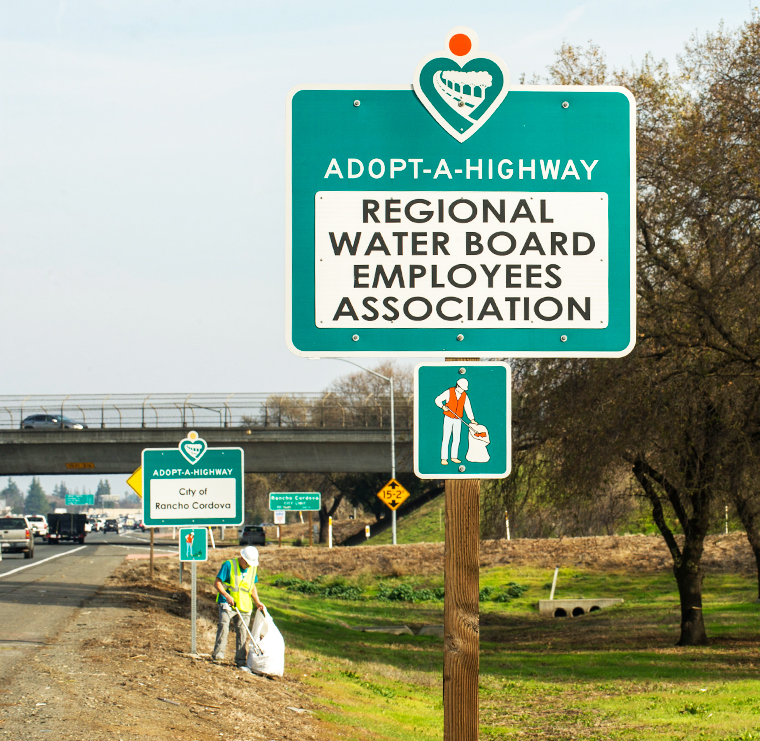
A volunteer with Caltrans’ Adopt-A-Highway program fills a bag with trash collected along U.S. Highway 50 in Rancho Cordova. This particular route was adopted by employees working for the Central Valley Regional Water Quality Control Board, one of nine state boards across California that protect and regulate water resources.
Caltrans has diverted more resources in recent years to meet its responsibility collecting trash discarded by drivers or strewn onto roadways by vehicles without a tarp, illegal dumping activities, and other sources that contribute to the unsightly roadsides.
In addition to being a potential threat to the environment, roadway litter poses a safety hazard to the traveling public and Caltrans maintenance workers. Clean California takes direct aim at this challenge with an investment of $418 million specifically for litter collection.
While Clean California directs significant funds to traditional trash collection, it also devotes nearly $600 million through two programs to clean up and beautify the state’s travel network.
Clean California is projected to create approximately 11,000 jobs through state and local efforts, including low-barrier maintenance jobs for vulnerable populations, as well as opportunities for local artists. Notably, these hiring efforts are creating career opportunities for veterans, students, people experiencing homelessness, and those re-entering society from incarceration.
Gov. Newsom has asked Caltrans to meet the moment, and the department has responded with an ambitious slate of litter collection activities and by advancing projects that will connect and unify communities, demonstrated by the following highlights:
Litter Abatement
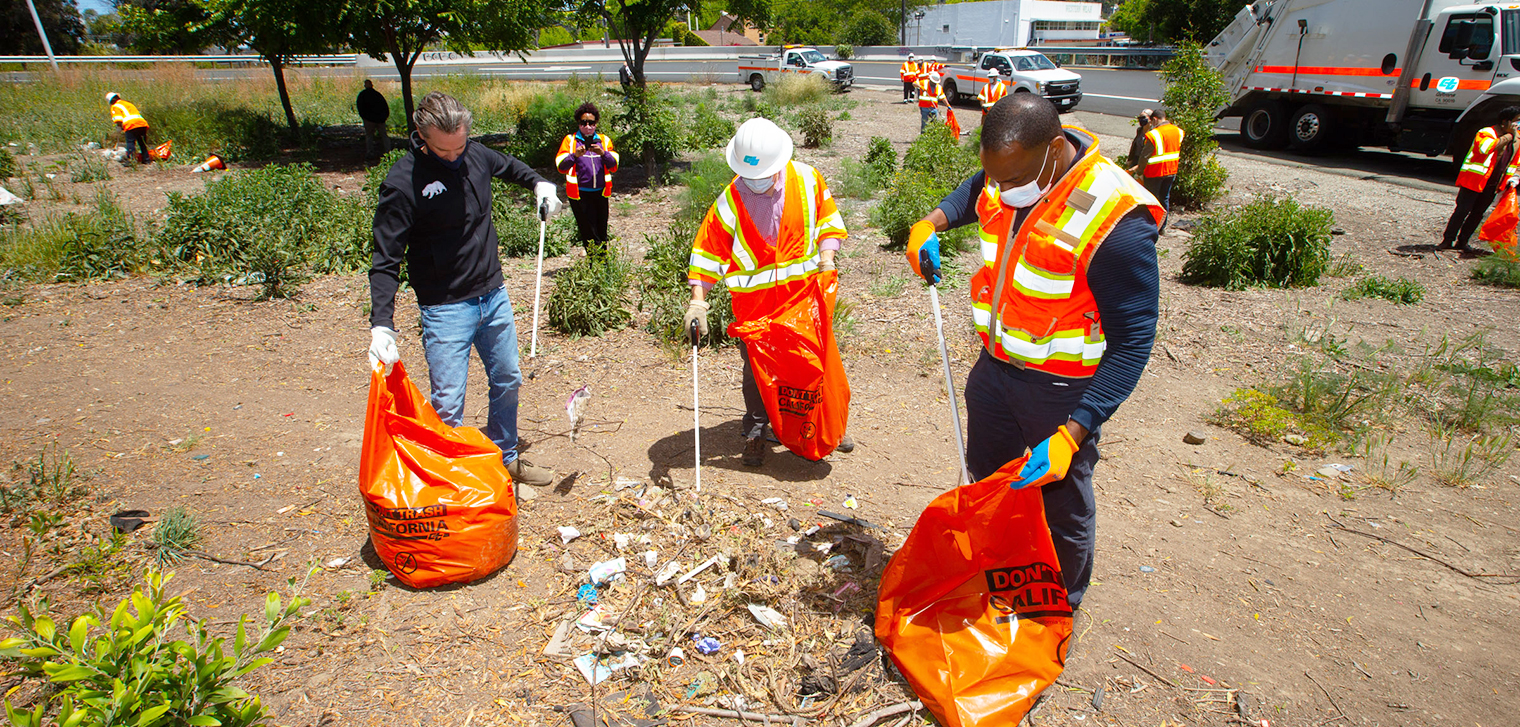
The program is already making a major, positive impact. As of June, Caltrans has collected nearly 646,000 cubic yards of litter, or more than 10,800 tons, from the state highway system, enough trash to fill 197 Olympic-sized swimming pools. Clean California also has provided much-needed funding to buy 269 pieces of equipment to sustain safe litter collection efforts.
Clean California has also led to more than 700 new Adopt-A-Highway sections. Caltrans announced a $250 monthly incentive stipend in October 2021 funded by Clean California for qualifying litter clean-up events that has further promoted volunteerism by groups and people dedicated to keeping California’s roadsides clean.
Caltrans has also hosted 114 Dump Day Clean California events during the first 10 months of the program, collecting more than 34,600 cubic yards of litter, including 13,339 tires and more than 3,100 mattresses. Caltrans regional districts statewide continue to coordinate and plan additional events with the aim of holding monthly cleanup activities. Each of Caltrans’ 12 regional districts held Dump Day events as part of a statewide effort for Earth Day on April 23.

Caltrans is evaluating technology to optimize data and decision-making processes, including a partnership with Google to use its Street View and artificial intelligence to enhance litter assessment accuracy, and pilot Adopt-A-Highway mobile applications to collect and analyze real-time data.

Job Creation
Caltrans has filled 546 litter collection maintenance positions. These entry-level jobs offer professional development and career opportunities for Californians, including people experiencing homelessness and the formerly incarcerated.
Clean California is partnering with the Butte County Office of Education (BCOE) to employ people overcoming barriers to work. The BCOE Back 2 Work Program is a transitional employment program for underserved and disadvantaged adults. Building on the success of this partnership, Caltrans significantly expanded the program in 2021, signing a $127 million contract with BCOE – funded by Clean California – to hire 82 additional Back 2 Work crews statewide. Each crew has an estimated 50 participants annually, providing more than 4,000 people with the opportunity to reintegrate back into the workforce. In addition to providing paying transitional employment, the program offers support services to help participants overcome employment barriers, get jobs, stay employed and build a better life.
State Beautification Projects
Caltrans is launching more than 120 beautification and safety enhancement projects on the state highway system, investing $311 million to transform areas blighted by trash and debris, including neighborhoods divided by highways. The community-driven projects will improve public spaces, incorporate artwork, add trees and other green elements, and reconnect underserved communities. Advertisement of projects for construction began in April 2022.

Clean California Local Grant Program
Caltrans is funding nearly $300 million for 105 local projects throughout the state to beautify local streets, roads, parks and pathways. These projects will generate more than 3,600 jobs, with every project benefiting an underserved community.
Governor Newsom announced the recipients of the Clean California local grants on March 1. Following the drafting of guidelines and grant workshops, Caltrans received more than 300 applications totaling $758 million — more than double the available funding — which were scored by a team of 144 evaluators. The awarded projects were selected based on demonstrated community benefit and need. Gov. Newsom's California Blueprint proposes an additional $100 million to fund a second round of Clean California local grant projects.

Public Education Campaign
Clean California includes $33 million for a three-year, multi-faceted public education campaign to raise public awareness about the negative impact of litter and encourage Californians to do their part to keep our state clean.
Source: Caltrans Clean California program
![]()
Projects Honor, Protect a Way of Life
Department Dedicated to Collaborating With California’s Diverse Tribes
At the places where state roadways and Native American tribal lands intersect, Caltrans takes great care to respect and protect the safety, cultural identity and sacred lands of California’s original inhabitants.
One example of the collaboration between the department and tribal neighbors is in Caltrans’ District 1 region, the land of towering redwoods and crashing coastline that is home to the Yurok tribe, whose descendants have lived in this magical part of California long before non-Indian exploration and settlement occurred.
Caltrans and Yurok tribal representatives are now heralding the completion of the Pectah Wall Project, a shared goal to improve pedestrian safety in the village of Weitchpec on the Yurok Reservation, sited along a twisty, 44-mile portion of the Klamath River in Del Norte and Humboldt counties. (The reservation is a rare example in California of a native people not having been forcibly removed from their ancestral lands.)
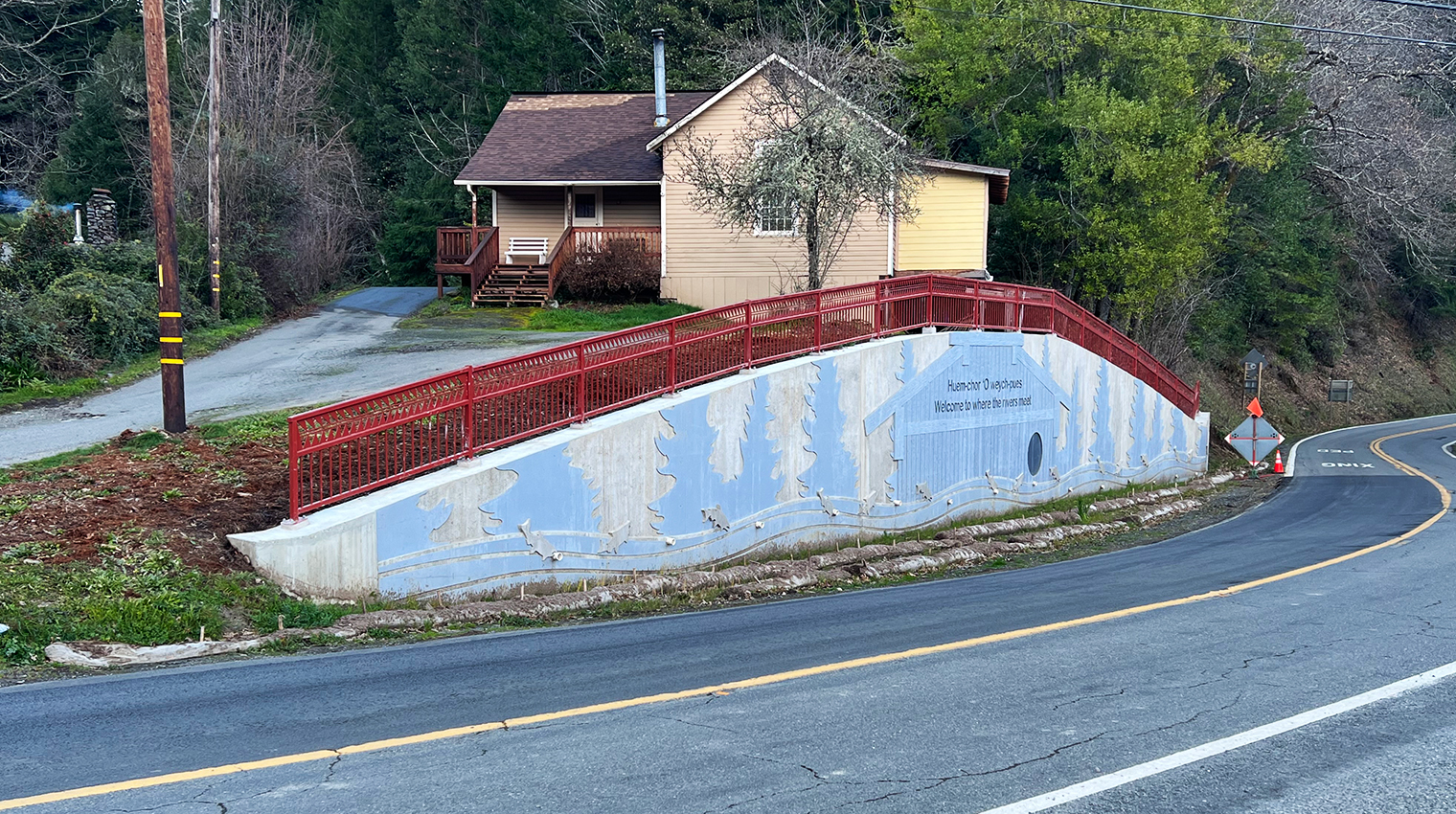
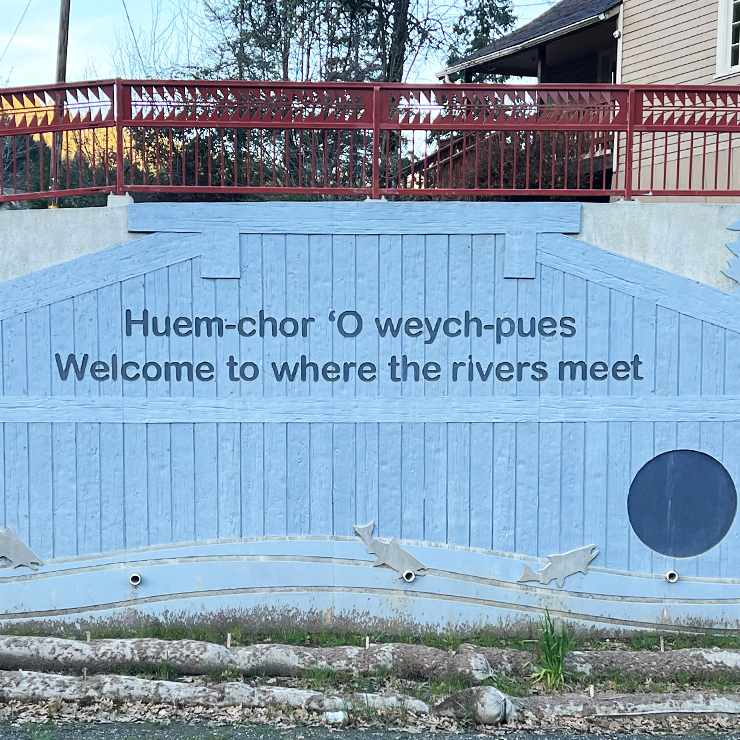
U.S. Highway 101 and State Route 96 run through the 50,000-acre-plus reservation, which extends from the Pacific Ocean coastline inland to the unincorporated community of Weitchpec. State Routes 96 and 169 intersect at Weitchpec, which is also where the Klamath and Trinity rivers meet.
Tribal elders of the Yurok, a tribe whose 6,000-plus members live throughout Northern California, often walk across the state-maintained highways as they go about their daily lives and ceremonial duties.
In Weitchpec, the roadway has a store/gas station on the north side of the highway, church and community mailboxes on the south, and houses on both sides, leading to frequent pedestrian crossings.
Due to limited sight distance, drivers traveling east on SR 96 round a corner into Weitchpec and can quickly encounter people crossing the road with limited time to react, especially if they aren’t obeying the speed limit or paying attention.
Because of concerns expressed by Weitchpec community members, the Yurok Tribal Council requested safety improvements for that stretch of state highway. District 1 staff conducted two investigations in the area that confirmed the need for increased sight distance on SR 96, and Caltrans and the Yurok tribe began work toward a solution.
In assessing possible remedies, Caltrans project staff determined there was no room to widen the road by cutting into the existing bank. Any widening project would take out the church to the south, and the houses and the store parking lot to the north — both untenable propositions. With that in mind, staff determined a wall would be the best way to improve pedestrian safety.
As part of the planning process, District 1 executive staff members met with the Yurok Cultural Committee — a group of tribal members that reviews all projects in the community — to discuss potential aesthetic treatments for the wall. Many of the elders and cultural practitioners suggested design elements that a Caltrans landscape architect was able to incorporate in conceptual graphics that were presented at a tribal meeting.
The Yurok tribe presented three design proposals to all tribal members throughout Northern California. One that depicted fish, trees and river, and a dual-language welcome sign received overwhelming support. Caltrans completed the wall earlier this year, and the Weitchpec community is now enjoying the safety benefits.
The Pectah Wall Project is just one example among many of the partnerships between Caltrans and Native American tribes in the state. Here are several other recent examples:
District 7
Caltrans District 7, which encompasses Los Angeles/Ventura counties, has engaged with local Native American cultural leaders on the Wallis Annenberg Wildlife Crossing at Liberty Canyon off U.S. Highway 101 in Agoura. Once constructed, the crossing will be one of the largest urban wildlife bridges in the world and provide a safe and sustainable passage for animals between the Santa Monica Mountains and Ventura County.
In another example of Caltrans’ tribal engagement efforts, District 7 also collaborated with local tribal cultural leaders/representatives to host a museum exhibit at the district’s downtown Los Angeles office in 2019. The temporary exhibit, We Are Still Here, celebrates the contributions of four Native American tribes and 20 communities in the greater Los Angeles region. The exhibit served as a reminder of the importance of considering the unique tribal knowledge and expertise that tribes possess about their ancestral lands in the department’s approach to the identification and treatment of significant tribal heritage sites in the context of transportation project developments. The exhibit has been adapted to a virtual format for all to view and learn.
District 4
District 4, which represents nine counties in the greater Bay Area, collaborated with the Kashia Pomo for a Cultural Landscape Project, which won the Governor’s Historic Preservation Award in 2017. Caltrans workers and representatives of the tribe, whose coastal homeland begins just north of Jenner along State Route 1, documented the Kashia Pomo’s historical and cultural association with the land. The gathered information can help Caltrans make repairs to the iconic roadway in a respectful way, avoiding conflicts with the tribe and its members. This Caltrans NewsFlash describes the project.
In conjunction with Caltrans’ Division of Transportation Planning and Project Delivery program, the Cultural Studies Office has developed a web-based research tool and map tool to aid in the research of California tribal heritage efforts. The Roadmap to Research webpage connects users to a database of publicly available historical and anthropological records, archives and studies in California. The Roadmap to Research site promotes research and awareness of the wealth of original source material and information for which fresh interpretations by Native Californians may be needed. This resource is intended as an access-for-all approach to guide users to original source information that might otherwise have only been known and used by academic researchers.
Find out more about how Caltrans works with Native American tribes, or request assistance on tribal consultation and diplomacy in the context of planning and transportation development activities, by visiting the Caltrans Tribal Relations webpage.
Sources: Lonora Graves, Caltrans Native American Liaison Branch Manager; Kathleen Sartorius, Project Engineer for the Pectah Wall Project, Sara Atchley Thomas, Native American Liaison, Caltrans District 1; Brandi Cottonreader, Caltrans Equal Employment Opportunity Program; Jody Brown, Caltrans Cultural Studies Office Chief, Division of Environmental Analysis.
Caltrans’ Native American Outreach Involves Multiple Offices, Regional Districts
With California home to the highest number of Native American tribes in the contiguous U.S., Caltrans recognizes the importance of communication, coordination and meaningful consultation with tribal leaders and representatives on transportation issues of local impact. There are 109 federally recognized tribal governments in the state, second only to Alaska, and approximately 80 non-federal tribal governments and affiliated nonprofit organizations recognized by the state of California.
Caltrans’ responsibilities for interacting with tribal governments are defined in its Director’s Policy 19 (Working with Native American Communities), the California State Transportation Agency’s Tribal Consultation Policy, and the Governor’s Executive Order B-10-11.
Caltrans’ Tribal Relations team based at its Sacramento headquarters provides leadership and direction that guides the Department’s diplomatic and consultation responsibilities with tribal governments. About 30 full-time employees at Caltrans work on Native American issues involving transportation. Staff members serve as liaisons between California’s Native American tribes and Caltrans’ leaders, managers and staff, as well as local and regional transportation agencies and other key stakeholders. The responsibilities of the Tribal Relations team spans the spectrum of transportation development, from early project planning to project delivery, environmental review, construction, and maintenance operations.
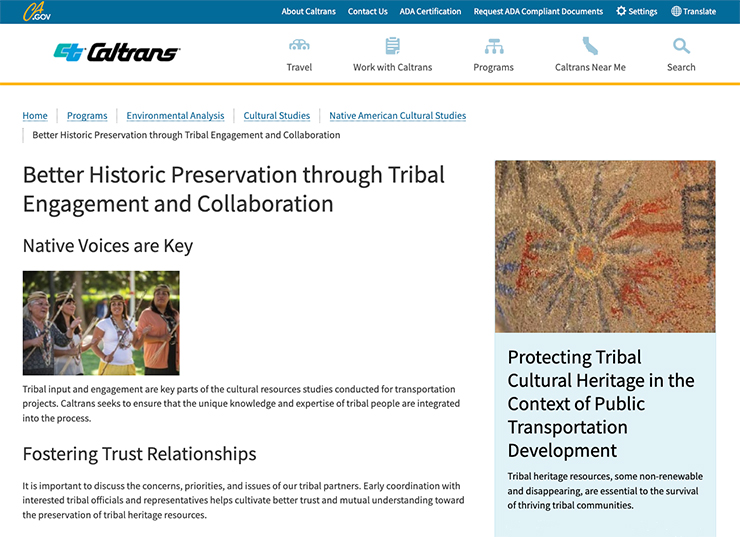
Caltrans has two branches that work under its Tribal Relations umbrella. The Native American Liaison Branch operates within the Office of Race and Equity in the Planning and Modal Program, while the Native American Cultural Studies Branch works on behalf of tribal issues under the Division of Environmental Analysis in Project Delivery. The Liaison and Cultural Studies branches both coordinate and consult with tribal governments in the context of transportation planning and project development decisions. The branches develop recommendations and alternatives in response to federal and state legislation and regulations, and also work together to develop agreements on project scope and details.
The Tribal Relations team at Caltrans headquarters serves as the primary government-to-government contact between the department and tribal governments and advises Caltrans’ executive management on relevant policy issues. The team also serves as advisors on Native American diplomacy.
As part of the department’s Planning and Modal Program, the Liaison Branch addresses tribal transportation mobility and safety needs, and funding sources. It serves as a resource for regional transportation agencies and Caltrans planners on the appropriate methods of tribal government involvement required during the transportation planning process. This branch is instrumental in providing tribes with technical assistance and connecting them with grant opportunities that help tribal members participate in important local and regional planning processes — an important part of Caltrans’ efforts to help create tribal capacity and advance equity.
The Native American Cultural Studies Branch, as part of Caltrans’ Environmental Analysis division under Project Delivery, addresses statewide programs and policies related to the department’s responsibilities when transportation activities may affect tribal cultural and natural heritage sites, resources, and landscapes. This branch helps ensure compliance with federal and state historic preservation, environmental, and sacred site protection laws, and its responsibilities also include supporting Caltrans’ diplomatic engagement with tribal partners on sensitive cultural and environmental issues.
Both branches, in conjunction with other partners and stakeholders, engage with tribes regularly through statewide, regional, and/or meetings on specific topics or issue. These meetings include the quarterly Native American Advisory Committee meetings and quarterly Cultural Studies Subcommittee meetings, as well as regular district and/or regional tribal meetings, summits, listening sessions, and focused project-level meetings.
Tribal Relations staff in the 12 districts, working with the Liaison and Native American Cultural Studies branches at Caltrans headquarters, do vital, ground-level work with tribal governments in the context of planning, project delivery, construction, local assistance, encroachments, maintenance and operations, right-of-way, and contracts and procurements. These liaisons, coordinators, and cultural resources professional staff serve as primary points of contact and front-line ambassadors with the tribes in their respective regions.
One example of where Caltrans has modified its activities as a result of this cooperation is in its maintenance program, where pesticide use has been curtailed or mowing practices modified in certain areas to allow tribal members to safely collect native plants.
Caltrans’ Tribal Relations team also support effective working relationships between local agencies and culturally affiliated tribes of their regions through the department’s Local Assistance program.
In turn, tribal representatives with expertise consistently share their tribe’s traditional knowledge during cultural resources investigations conducted by Caltrans during project delivery and/or maintenance activities. Culturally affiliated tribal representatives engage in archaeological studies, site monitoring, surveys, and/or other activities on behalf of their tribe and in coordination with Caltrans’ professionally qualified staff archaeologists.
There are many opportunities for collaboration with tribal governments, in conjunction with local and regional partners, that may lead to more effective and efficient processes and mutually beneficial outcomes. Caltrans’ Tribal Relations team seeks to foster such opportunities by promoting early coordination and integrated partnerships that support the department’s mission, goals, and strategic imperatives.
Sources: Lonora Graves, Native American Liaison Branch Chief, Caltrans Office of Race and Equity; Sarah Allred, Native American Cultural Studies Branch, Cultural Studies Office, Caltrans Division of Environmental Analysis.
![]()
Caltrans, State Push Fire-Resilient Roadways Strategy
Aggressive vegetation management lowers danger along vulnerable routes
With the memory of California’s most destructive fire season still vivid and the threat of a 2022 repeat lurking, Caltrans is continuing to improve its vegetation management practices to reduce the risk of fire for travelers and communities along roadways that face wildfire danger.
The department’s fire-resilient strategy has a reinvigorated vegetation management planning process at its core. Caltrans refined its process in a series of winter workshops with local fire officials and other stakeholders to share insight and strategies on adapting to wildfire risk within state highway right of way.

The winter workshop series began in the San Francisco Bay Area to identify where to expand Caltrans’ vegetation management program in the East Bay, a drier microclimate hosting forests and grasslands amid a highly urban setting. The workshops addressed requests by the area’s fire chiefs to exchange knowledge about changing weather conditions, combustible fuels buildup, and the probability of wildfire ignition along key highway corridors that could be evacuation routes during large wildfires.
The model highway roadside adapted to wildfire risk will have a more open appearance, with broader spacing between individual mature trees, acres of thinned brush with an understory of new growth shaded by the overhead canopy. Achieving this roadside prescription, where it can be adapted, will not supersede state and federal environmental laws or Caltrans’ other roadway responsibilities.
To reduce the risk of wildfire ignition, Caltrans has stepped up herbicide, mowing and brush removal schedules to maintain low-growth strips up to 10 feet wide, depending on the setting. In grassland areas that are inaccessible or too expansive for regular mowing, CalFire recommends controlled burns as a cost-effective treatment to contain regrowth. (Caltrans does not perform these burns. CalFire is responsible for fire prevention measures.)
Starting with District 4, all 12 regional districts held workshops by the end of March 2022 in preparation for another hot, dry summer.
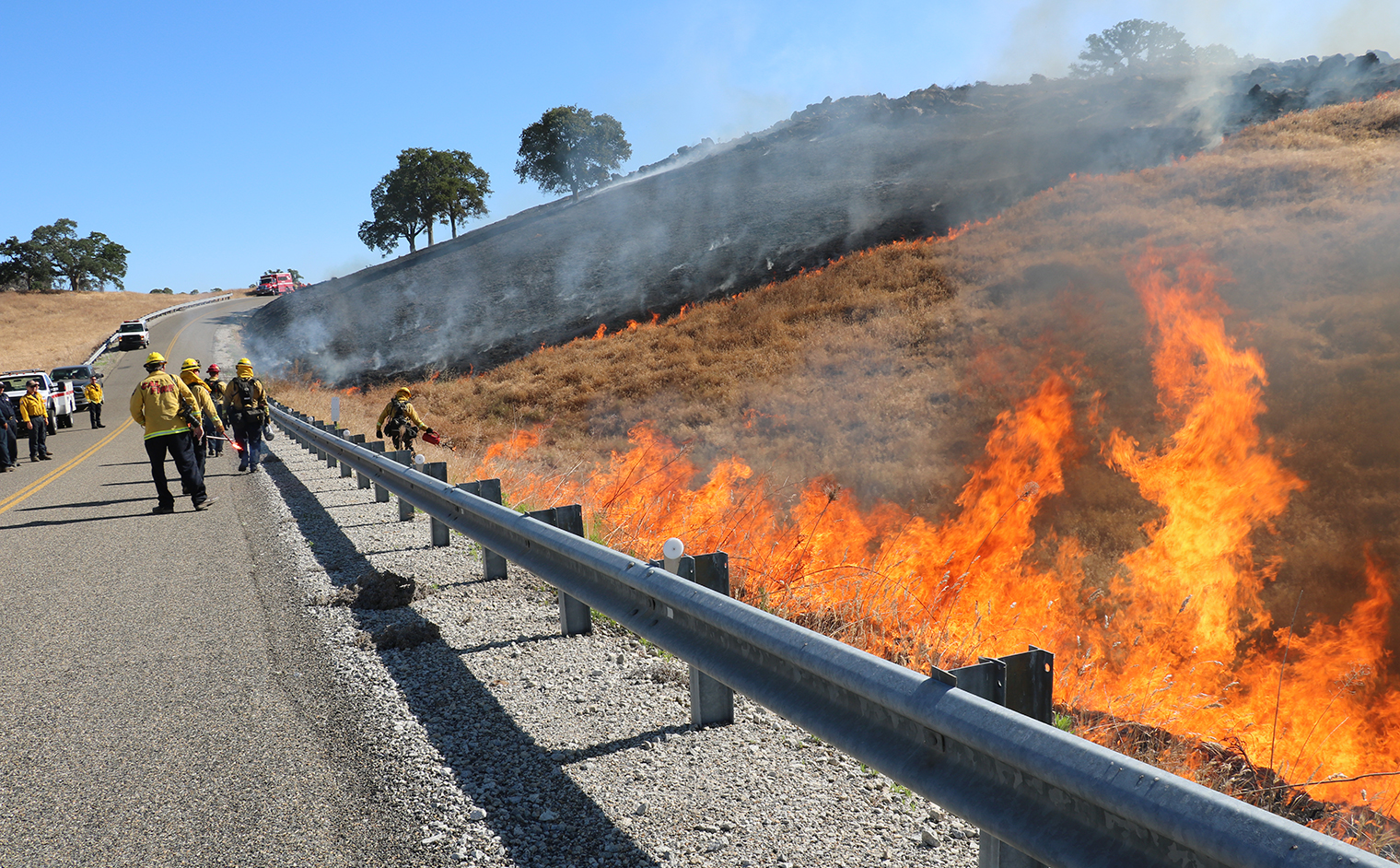
More aggressive vegetation management policy
Caltrans has long practiced vegetation control of weeds and grasses along the edges of state highways to ensure drivers have an unobstructed view of guardrail, signs, barriers and lane striping. In the last several years, however, as climate change has begun to grip California with extreme droughts and disastrous wildfires, Caltrans re-examined its historic vegetation control practices and embarked on a more comprehensive and aggressive fuels reduction strategy to reduce wildfire ignition probability and establish shaded fuel breaks along travel routes it maintains.
Caltrans also is supporting a broader Fire-Safe Roadways campaign, joining other local, state and federal agencies in Governor Gavin Newsom’s California Wildfire and Forest Resilience Task Force. Amid changing climate conditions in the state that help spawn larger, more destructive fires, the task force is countering with a strategy to build the resilience of the natural environment along roadways. As a result of the task force, Caltrans is aligned to receive technical insight from CalFire, the U.S. Forest Service, tribal representatives and local fire officials who practice fire prevention and natural resource management.
The task force released the California Wildfire and Forest Resilience Action Plan in January 2021. The comprehensive report establishes a series of goals to protect communities and forests from fire, and assigns participating entities, including Caltrans, to work on a 100-point action plan to reduce fire fuels buildup in California.
Modernizing roadside vegetation control
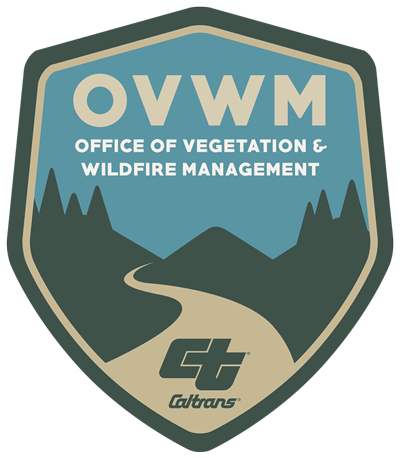
As the state’s fire prevention efforts progress, Caltrans’ HQ Maintenance Office of Vegetation and Wildfire Management partnered with District 4’s Division of Maintenance on modernizing its roadside management of natural vegetation within the right of way.
Intended as a pilot project to inform Caltrans’ statewide efforts, the East Bay Vegetation Management Plan identifies high-priority roadside locations within the state highway network in Alameda, Contra Costa, Marin and Santa Clara counties for additional fuels reduction. Working in partnership with local, state and elected officials, Caltrans is augmenting in-house vegetation control with contracts for more extensive clearing services along seven key highway corridors in the four Bay Area counties, totaling 59 centerline miles of comprehensive vegetation management.
The conditions along those corridors will determine the type of vegetation treatment and width of the buffer needed to mitigate fire risk to the traveling public, adjacent communities and Caltrans personnel, according to the East Bay plan.
Caltrans completed one major fuels reduction project in the area last year along State Route 17 in Santa Clara County as part of a statewide effort by CalFire to reduce fire loads on key corridors. More larger-scale projects are planned for this fiscal year. Caltrans is seeking bids on seven major fuel reduction contracts, part of the $31 million that the department is devoting to lessening fire danger on critical state routes.
In all, there is funding for contracts that will reduce fuels buildup on more than 500 lane-miles of state highway within two years. Federal infrastructure funds could further expand Caltrans’ fuels reduction campaign in the 2022-23 fiscal year.
Other Caltrans regional districts are scheduled to use the District 4 vegetation management framework to draft their own fuels reduction strategy, and overlay the conditions particular to their area, proposed actions and a time frame into that template.
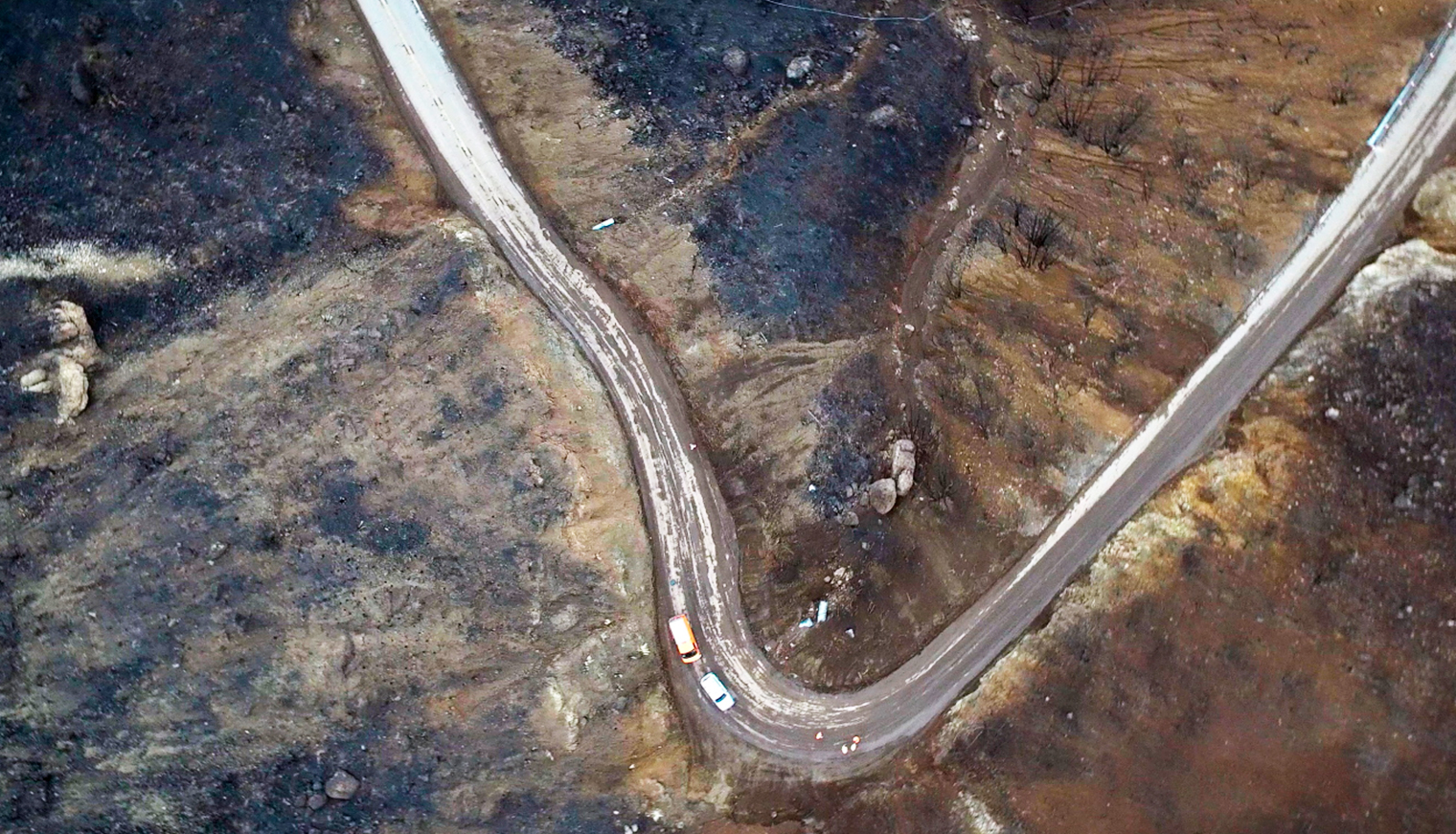
Analysis reveals fire risk to state routes
A Caltrans Wildfire Vulnerability Analysis prepared in 2019 and repeated in 2020 confirmed that a significant portion of the state highway network is vulnerable to wildfire.
The research by the University of California, Davis, and an environmental consultant mapped state highways in all 12 Caltrans districts in one-mile segments. The analysis, using geographic information system mapping software, applied 20 different risk factors, including population, resources and emergency capacity, to determine each highway section’s risk profile.
The four-month study, which was duplicated the following year to confirm the findings, found that more than 2,600 centerline miles of state highway, 17.3% of the 14,993 total centerline miles in the state, need some degree of fuels reduction effort. (Centerline miles are measured by road distance and don’t take multiple lanes into account.)
Highways in Caltrans districts in the northernmost parts of the state faced the most danger, the analysis found, while districts in the more arid south state had fewer state travel routes at risk. District 4, with an expanse of drier, inland wooded areas alongside population centers, has 102 centerline miles needing fuels clearance, about 7 percent of state highway miles within the nine-county Bay Area district.
The need for a new level of vegetation control has been identified by Caltrans climate studies that predict hotter temperatures and changing precipitation patterns in California through this century will result in drier forests and foothills — raising the likelihood of catastrophic fires.
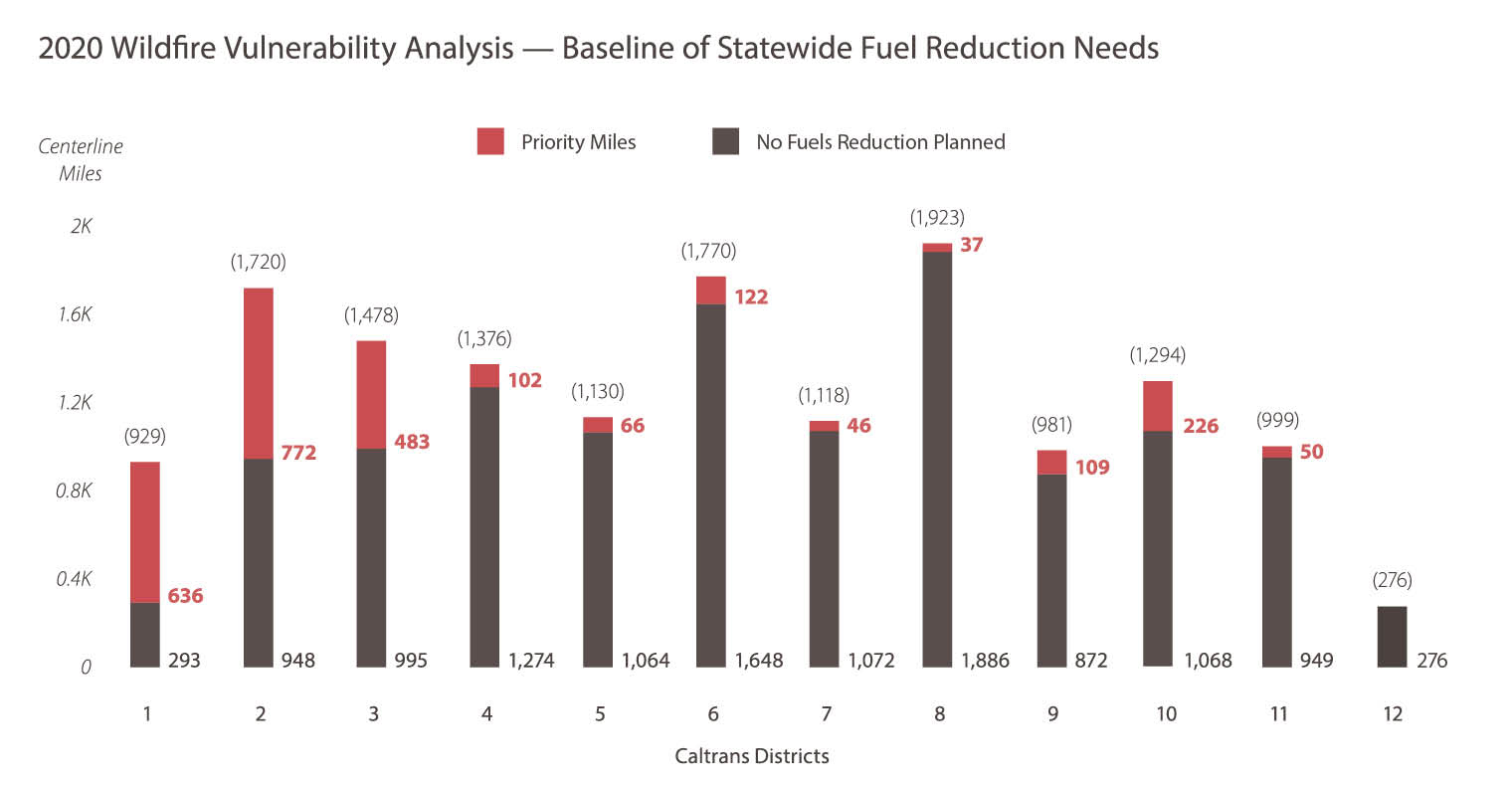
Million-acre fuels reduction plan
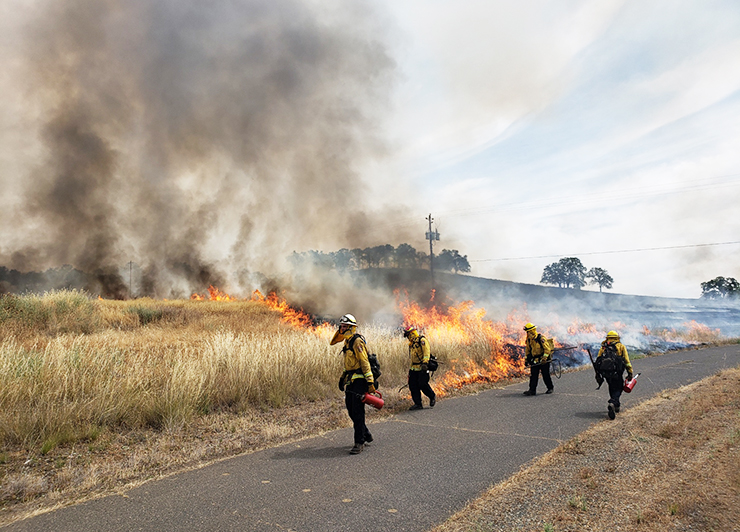
The state task force’s work dovetails with Caltrans’ involvement in Gov. Newsom’s $1.5 billion wildfire and forest resilience program, part of a $15 billion-plus climate package announced by the governor in September 2020. The 100 assignments in the Wildfire and Forest Resilience Action Plan support the ultimate goal of expanding fire fuels treatment in California forestlands to one million acres annually by 2025.
Caltrans is taking the lead on six action items on behalf of a Fire-Safe Roadways goal in the 100-point state plan:
- Identify subdivision secondary emergency access.
- Develop a framework to create road corridors less susceptible to fire.
- Assist with area government’s general plans.
- Expand highway treatments.
- Develop good neighbor agreements.
- Expand a messaging campaign.
Caltrans also established a Vegetation and Wildfire Executive Steering Committee in August 2021 in support of the action plan. The executive committee’s intent is to coordinate a shift in Caltrans’ vegetation management practices that is inclusive of external fire agency expertise, updates policy, implements new workflow processes and shares best practices.
Forest thinning projects represent another fuels reduction strategy for Caltrans along state highways, in cooperation with CalFire, U.S. Forest Service and local entities. Since 2015, Caltrans and its contractors have removed nearly 180,000 dead or dying trees that posed a threat of interfering with or obstructing travel along state highways. Many of those fallen trees, part of a massive die-off caused by prolonged drought or bark beetle infestations, were fed into biomass plants that generated enough electricity to power more than 21,000 California homes in one year.
With its expanded vegetation management practices, increased fuels reduction funding, and partnerships to leverage projects with local and state fire agencies, Caltrans’ maintenance operations help make our roadways more fire-resilient, one post-mile at a time.
Source: Caltrans Division of Maintenance; Office of Vegetation and Wildfire Management
![]()
Project Spotlight: Otay Mesa East Land Port of Entry
Caltrans a key player in creating new trade/travel corridor between U.S., Mexico

The finish line is in sight for a massive construction project to create a new land port of entry between the U.S. and Mexico, a 20-year-plus undertaking that Caltrans has been a key player in developing and building.
When complete, the State Route 11/Otay Mesa East Land Port of Entry project will open a new trade and travel corridor between the two nations that is expected to reduce border wait times, reduce greenhouse gas emissions, bolster economic growth, enhance regional mobility, strengthen border security and resiliency, and reinforce a binational and regional bond.
The new port of entry, with state-of-the-art multimodal features and companion facilities, is being delivered at a critical time in the history of this mega-region that links the two countries. Approximately 7.3 million people live on both sides of the 150-mile international border separating California and Baja California. One out of every 10 persons entering the U.S. crosses through one of the seven California land ports of entry located in Caltrans regional District 11, with about 154 million people crossing the California/Baja California corridors from both directions in 2019.
The San Ysidro port of entry is the busiest land port of entry in the Western Hemisphere, while Otay Mesa port of entry (only 13 miles away) is the second busiest commercial/cargo facility on the southern border.
An economic bridge unites nations, regions
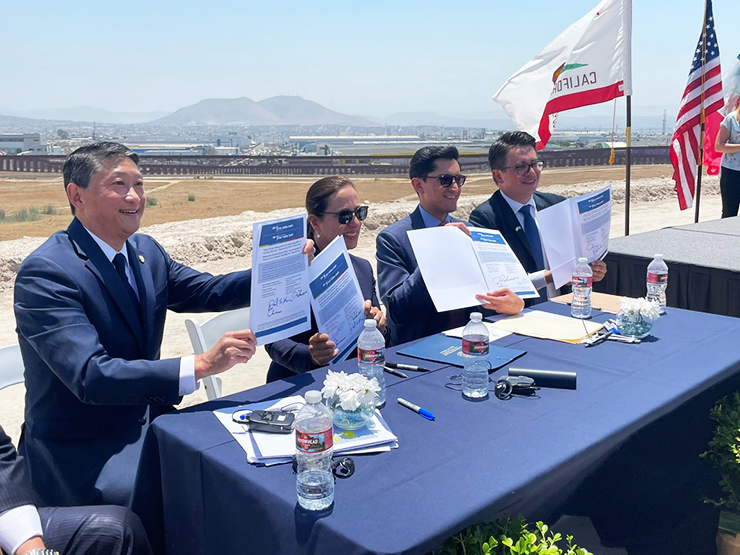
At a 2021 ceremony at the future site of the Otay Mesa East Port of Entry, from left, then-CalSTA Secretary David Kim and California Lt. Governor Eleni Kounalakis signed a memorandum of understanding for various operations with Roberto Velasco, Mexico’s undersecretary for North American Affairs of the Ministry of Foreign Relations, and Rogelio Rivero, director general for Mexico’s Roadway Development for the Ministry of Communications and Transportation.
The proximity between cities on both sides of the border has resulted in an interdependent relationship, including shared economic, social, and environmental concerns, border infrastructure, and a linked transportation system. California’s biggest trading partner is Mexico, with more than $72 billion in goods exchanged in 2020, an amount that is expected to increase significantly in the coming years with the recent passage of the United States-Mexico-Canada Agreement.
Ninety percent of this trade occurred via truck, and about 72 percent of the total California trade with Mexico used the existing Otay Mesa point of entry.
However, the volume of goods, and visitors, that pass through the limited number of border entries has translated to lost time and productivity. Travelers crossing the border between Tijuana and San Diego in passenger vehicles historically experience wait times of up to two hours, with peak wait times sometimes exceeding five hours, and commercial vehicles wait one to two hours on average and for as long as more than four hours. The delays result in billions of dollars lost in economic output and tens of thousands of jobs lost in the U.S. and Mexico due to these border delays.
The pressures upon those two entry points led leaders on both sides of the border to begin taking action to add another trade/travel corridor in the 1990s.
Plans for Otay Mesa East take shape
In the mid-1990s, Caltrans leaders, in partnership with the San Diego Association of Governments (SANDAG), envisioned a new state-of-the-art Otay Mesa East point of entry to alleviate border chokepoints.
A 1998 signing of a Memorandum of Understanding by leaders from California and Baja California created the Otay Mesa-Mesa de Otay Binational Corridor, the first of many cross-border project milestones essential for the construction of the SR-11/Otay Mesa East Port of Entry (POE) Corridor Project.
The project development process formalized in 2006. Numerous other local, state, federal, and international accords were struck that have paved the way for the development of the new border crossing.
The project has undergone extensive environmental clearances to proceed, culminating in approval by the U.S. Secretary of State.
Caltrans also completed a complex acquisition process for more than 120 acres of right of way for the proposed port of entry site. The footprint for the associated facilities is larger than the current San Ysidro and existing Otay Mesa point of entries put together, and an approximate equivalent area for State Route 11.
Construction for the projects that lay the groundwork for the SR-11/Otay Mesa East POE Corridor Project began in October 2013, when work on the first segment of SR 11 began.
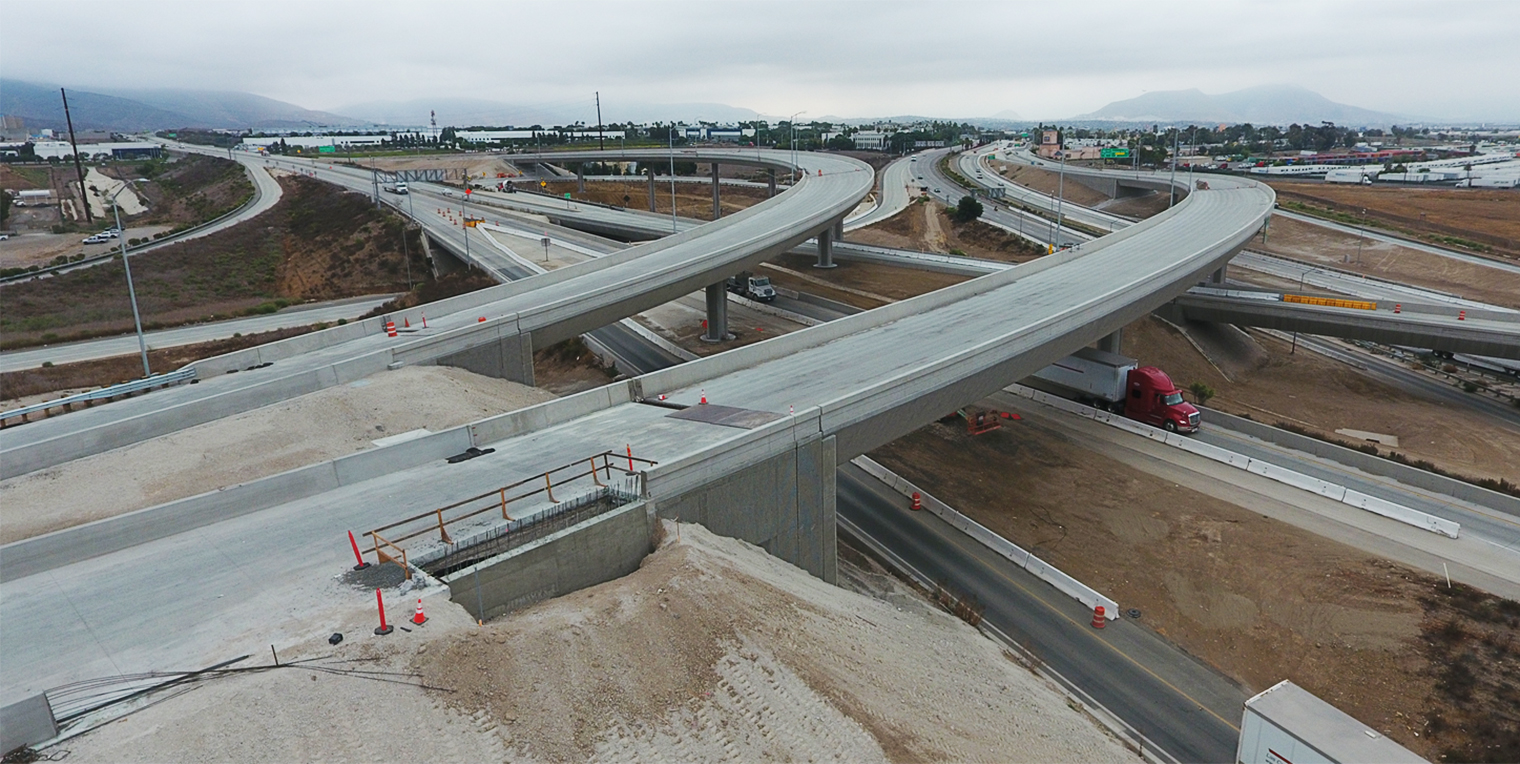
Transportation links mostly complete
Most of the transportation facilities are now nearing completion. Upcoming projects include site preparations, new utility services and utility relocations, bridging documents for the design and construction of the new port entry, and a California Highway Patrol commercial vehicle enforcement facility to be maintained by Caltrans. The anticipated completion date is September 2024.

Caltrans staff designed and constructed all roadway facilities associated with this point of entry, which pulled in 74 Caltrans employees, 29 consulting firms, and about 70 contractors’ personnel on any given day. These facilities include:
- The new State Route 11, which will provide direct access to the new port of entry.
- Three new freeway connections between SR 125, SR 905 and SR 11.
- A Border Wait Time Detection System, which will provide live information on wait status at other ports of entry in the region so travelers can make informed decisions on their routes.
- The new CHP enforcement facility, which should decrease wait times and improve secure border crossings for commercial vehicles.
- A new diverging diamond interchange, which should relieve truck traffic from the existing CHP enforcement facility and is the second of its kind in California.
These unique features of the SR-11/Otay Mesa East project are predicted to decrease peak wait times for border crossers by 50 percent upon opening of the port of entry, improve environmental sustainability by mitigating greenhouse gas emissions related to border delays, and generate approximately $1.8 billion in economic gains. It’s also estimated that the new port of entry, by helping unkink a major supply chain obstacle, will save more than 16,000 jobs by 2025, and will ultimately provide an overall cost/benefit ratio of 10-to-1.
Less waiting in line = Cleaner air
In addition to decreasing border wait times, the project’s integrated operations system also should cut down emissions from idling traffic. Today, border delays at California-Baja California land ports of entry produce an average of 457 metric tons of carbon dioxide emissions daily.
According to a recent analysis, carbon dioxide levels will drop by 22 percent between 2016 and 2035, supporting federal, state, and environmental justice goals and improving regional air quality.
The SR 11/Otay Mesa East project has received strong financial backing from the state of California. The project is funded through federal, state, and local sources.
About 40 percent of the secured project funding, totaling nearly $600 million, comes from Senate Bill 1’s Trade Corridor Enhancement Program, and the State Highway Operations and Protection Program (SHOPP). In October 2021, the California Transportation Commission allocated $24.9 million in federal Coordinated Border Infrastructure Funds toward construction of the project.
The Otay Mesa East POE will be the first national border crossing project to incorporate dynamic tolling based on congestion, which is intended to allow reliable and predictable border crossings with an average wait time goal of 20 minutes.
A binational partnership
The project has been a prototype of binational coordination, with jointly developed studies on traffic and revenue, traffic approach management on both sides of the border, and dynamic tolling. An example of this cooperation came in June 2021 when the state of California, local partners, and the Mexican federal agencies signed a Memorandum of Understanding outlining major milestones and goals of the project, such as toll sharing, mirrored intelligent transportation systems, and opening date of late 2024 for both countries.
Caltrans District 11, along with SANDAG, has been responsible for the project inception and continuity, working with Mexican government as well as with federal agencies that include the U.S. Department of Homeland Security, U.S. Customs and Border Protection, Federal Highway Administration, the Federal Motor Carrier Safety Administration and General Services Administration, as well as coordinating with multiple state and local agencies.
Source: Caltrans Regional District 11.
![]()
All Aboard to the Future
Hydrogen power is coming down the track for California's rail fleet
Through its Division of Rail and Mass Transportation, Caltrans is pushing to convert its full fleet of intercity locomotives to zero emission, or ZE, by 2035. Plans call for the trains operated by local transportation agencies to be powered by hydrogen, considered a sustainable, less-polluting and potentially cost-effective alternative to fossil fuels and other sources of energy.
Hydrogen power will put California’s passenger train fleet on the fastest track toward a zero-emission future.
Through its Division of Rail and Mass Transportation, Caltrans is pushing to convert its full fleet of intercity locomotives to zero emission, or ZE, by 2035. Plans call for the trains operated by local transportation agencies to be powered by hydrogen, considered a sustainable, less-polluting and potentially cost-effective alternative to fossil fuels and other sources of energy.
Under operating agreements with joint power authorities and Amtrak, Caltrans supports three intercity rail lines — the Capitol Corridor, between Auburn and the Bay Area; the San Joaquins that connect the Central Valley from Sacramento and Oakland to Bakersfield; and the Pacific Surfliner, between San Luis Obispo and San Diego — with a total of 37 locomotives, including 24 made by Siemens that were delivered in 2017.
Before a planned changeover to hydrogen power, Caltrans expects that by 2023, its entire locomotive fleet will run on renewable diesel, a relatively new fuel alternative that contains up to 85 percent less polluting sulfur than ultra-low sulfur diesel. By 2025, Caltrans hopes to reduce fuel usage per train mile by 15 percent and launch a two-year hydrogen pilot program. If the results meet expectations, the Department then could begin converting its fleet of locomotives that now use carbon-based fuel to hydrogen, or in some cases, replace old locomotives with new ZE locomotives and/or trainsets.
Caltrans has committed to these broad strategies for ZE trains in the intercity rail network:
- Provide leadership and guidance and serve as a positive benchmark for other railways to act quickly in a coordinated manner.
- Enable the launch of important initiatives and accelerate progress.
- Set targets and provide a structured approach to move towards ZE, including setting technological cornerstones.
- Respond to urgent needs and legislation/state mandates.
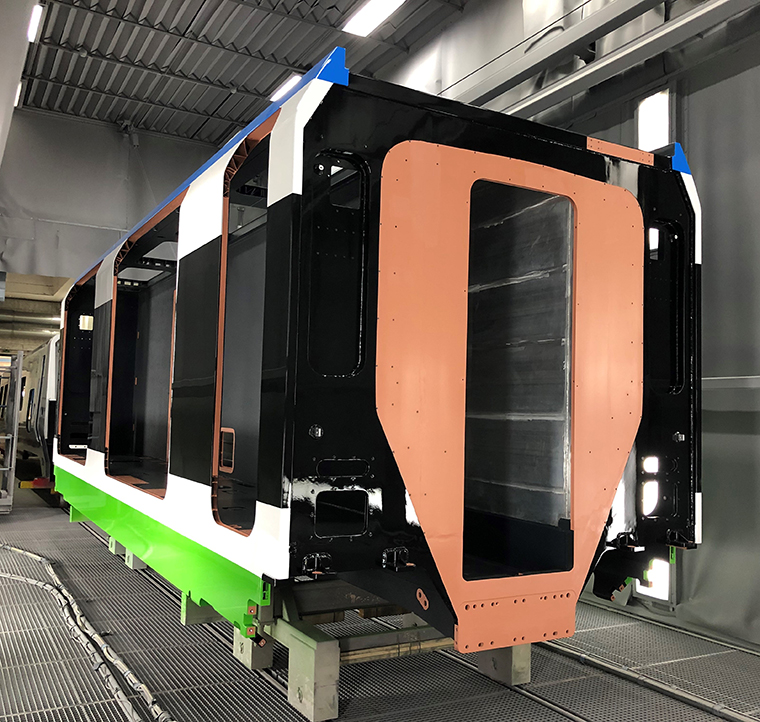
In addition to converting its locomotive fleet to hydrogen power, Caltrans plans on making investments in other areas of propulsion technology and procedures to make the fleet more energy-efficient, including:
- Purchasing next-generation rail cars and multiple-unit trainsets.
- Converting to regenerative braking that recovers and stores energy, reducing the demand of so-called head-end power such as heating/air conditioning systems and lighting.
- Adopting energy-efficient driving techniques.
The Division of Rail and Mass Transit looks to lead and promote pioneering initiatives in ZE vehicles, integrate statewide efforts to accelerate implementation, partner with Caltrans’ Division of Equipment and transit agencies to develop heavy-duty fueling infrastructure, and engage in public outreach that promote the benefits of rail.
Zero-emission trains are just one part of California’s comprehensive strategy to reduce the release of carbon-based pollutants from the transportation sector. Other far-reaching zero-emissions mandates will take effect in the coming years, including requiring bus sales be ZE-only starting in 2029, followed by new passenger cars and trucks in 2035, conversion of bus fleets of public transit agencies to all-ZE by 2040, and medium- and heavy-duty vehicles to be fully ZE by 2045 wherever feasible. California also is building the nation’s first electrified high-speed rail network that will be powered by renewable energy.
Source: Momoko Tamaoki, Assistant Division Chief, Caltrans Division of Rail and Mass Transit
![]()
More Federal Dollars Strengthen State Travel Grid
Pandemic relief funds, record reallocation sent to Caltrans, local agencies
Transportation funding for Caltrans and local entities in California got a big boost from the federal government in 2021, and that inflow of money to improve the state’s travel network is continuing in 2022.
Unanticipated revenues, which consist of money not budgeted at the start of fiscal years, arrived in the form of COVID-19 relief funds approved by Congress in 2021, and through the “August Redistribution” that divides unspent federal transportation funds among states each year.
Caltrans and its regional transportation partners netted more than $1 billion from the Federal Highway Administration (FHWA) and the Federal Transit Administration (FTA) last year to recoup expected losses in revenues and fares from the effects of the pandemic.
COVID relief dollars disbursed
The first distribution of money came in the winter of 2020-2021 from the passage of the Coronavirus Response and Relief Supplemental Appropriations Act for highway infrastructure programs. California received $911.5 million, with the California Transportation Commission (CTC) distributing about $547 million of that amount to Caltrans and almost $365 million to local transportation agencies in a 60/40 split.
The CTC conducted several virtual workshops in spring 2021 to take input on how federal relief funds should be spent. For Caltrans’ share, there was broad consensus to route most of that money into the State Highway Operation and Protection Program (SHOPP), Caltrans’ primary “fix-it first” fund dedicated to travel network repair and rehabilitation. The SHOPP is a critical program for the Road Repair and Accountability Act of 2017 (SB 1).
Regional transportation agencies received $365 million to make up for revenue shortfalls during the pandemic.
Those agencies got additional money through a supplemental relief program overseen by the Federal Transit Administration (FTA). California transit agencies that serve rural or aging populations received $74.4 million in the winter of 2020-2021, money directed to Caltrans’ Division of Rail and Mass Transportation for distribution. Another $34.9 million arrived from the FTA in April 2021 to offset agencies’ maintenance and operational losses during the pandemic.
Past storm repairs reimbursement
In the latest round of good news for California transportation needs in 2022, Caltrans received word from FHWA that California will get $595 million as reimbursement for emergency travel route repairs that date back to the 1990s.
The state typically receives about $100 million annually as the federal government’s share for the costs incurred from storm damage repair of roadways. The true cost has been higher, however, with state and local governments picking up the lion’s share of those repair bills.
The $595 million will cover the federal government’s obligation for road damage caused by 30 past storm events in California.
Historic federal infrastructure funding
On November 15, 2021, President Biden signed the Infrastructure Investment and Jobs Act (IIJA), representing the biggest federal investment in our nation’s transportation infrastructure in a generation. Just on guaranteed funding alone, California will receive roughly $40 billion over the next five years for highways, bridges, public transportation, airports, safer streets and electric vehicle charging. The IIJA is expected to provide almost $1.9 billion in additional federal transportation funding for California in the upcoming 2022-23 fiscal year, according to calculations by Caltrans’ Division of Budgets. The portion dedicated to the state transportation network, maintained by Caltrans, will be 60 percent, while regional transportation agencies will receive 40 percent of the increased funding, consistent with historical funding splits.
The money will be apportioned as part of the state budget process.
State Budget
In early January, Gov. Newsom released the proposed state budget for the 2022-23 fiscal year, which represents the initial step in the budgetary process that is scheduled to wrap up in June. The proposed budget for Caltrans is more than $20 billion, which reflects an increase of almost $2.7 billion (or 15.5 percent) from the current FY 2021-22 budget, and represents the highest-ever proposed budget for the department.
Learn more about the governor’s budget proposals for Caltrans by visiting the state Department of Finance’s webpage.
Source: Caltrans Division of Budgets
![]()
Pavement Innovations Will Have a Lasting Impact
Caltrans and the UC: Partners on the Road to Durability
The highway of tomorrow starts with a vision and ends with construction.
It’s taking an idea and turning it into a plan to rebuild a major urban interstate freeway to endure six decades of weather and wear and tear.
It’s developing and testing a new formula for fast-setting concrete that allows motorists to drive on newly poured concrete pavement in just 24 hours instead of 20 days after the last pump truck departs.
Paving the way for these innovations over the years has been a collaboration between Caltrans engineers and University of California researchers. Their goal is to build longer-lasting roadways cheaper and faster, and in a way that makes them easier to maintain while lessening the inconvenience to motorists during construction and the impacts on the environment.
“The way we operate with Caltrans is unique in the United States,” said John Harvey, a civil and environmental engineering professor and director of the University of California Pavement Research Center (UCRC) in Davis, one of the few advanced labs in the world conducting scientific research on road materials. “It is an integrated process. Caltrans has ideas what we should do. We look around and see what the needs are. Together we put together a series of topics and figure out a way to do that.”
Last fall, Caltrans approved a three-year $32 million interagency agreement to continue the work of the Partnered Pavement Research Center project.
“Caltrans and California are better in countless ways because of their dedication and expertise,” said Tom Pyle, chief of Caltrans Office of Asphalt Pavement Program. “They have provided valuable contributions to greenhouse gas reduction, urban heat island, 100-year concrete and long-life asphalt.”
Pavements take a pounding throughout state
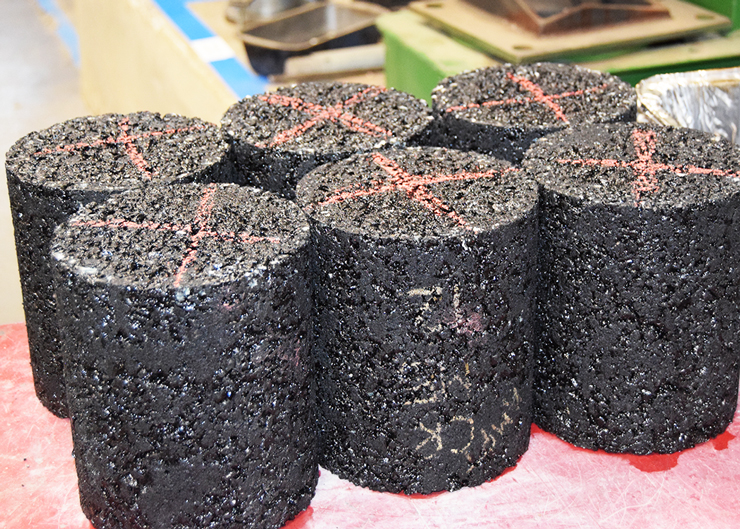
Asphalt core samples are ready for evaluation by researchers.
Indeed, pavement is a hot topic for a state known for its love affair with the automobile. Each year, motorists log more than 192 billion miles a year on the 52,000-lane miles of Caltrans-maintained highways.
The roadways certainly take a beating — from chained-up big rigs climbing over an icy Donner Summit on Interstate 80 to RVs venturing on a sunbaked State Route 190 in Death Valley to the commuter parade on Interstate 405 in Southern California.
“Nobody thinks about pavement until something goes wrong,” said Harvey.
Caltrans and UC have been working together to build a better road for decades.
State lawmakers created the Institute for Transportation Studies at UC Berkeley in 1948, with the first pavement testing station established in Richmond in 1994. Fourteen years later, Caltrans helped set up a second facility at UC Davis, which included materials testing labs, a test road area and two heavy vehicle simulators.
The Yolo County complex sits on the rural west end of the UC Davis campus. Stationed behind the buildings are two large Caltrans-owned orange heavy vehicle simulators built in South Africa in 1974. Operating around the clock, these machines roll airliner-type wheels back and forth on test pavement to simulate 20 years of highway wear in just three to six months.
Inside the labs, graduate and undergraduate students assist researchers to evaluate the properties of different pavement mixtures — aggregate, or crushed rock, and glued together with a binder such as asphalt or cement. Researchers see how a mixture behaves, looking for conditions such as rutting or cracking.
Under the partnership, Caltrans and the center develop a three-year roadmap outlining research and development projects covering the Department’s construction, environmental and maintenance programs. Topics range from updating design procedures for predicting pavement distresses to studying the effects of pavement roughness on the cost of freight movement.
Putting the research into practice is paramount.
“The benefit of research is zero unless it is implemented,” Harvey said. “Before it (research studies) sat on the shelf for a long time. There was no real drive to do it on the big scale. Now we’re seeing a much faster turnaround.”
Putting research into practice
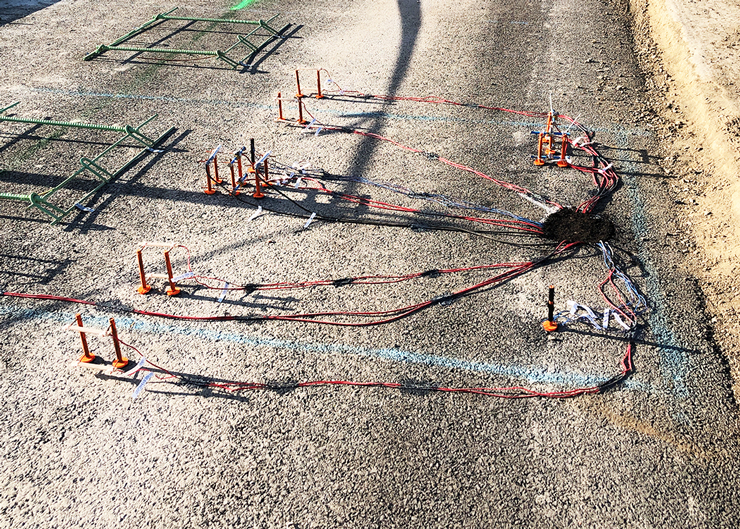
On a $370 million pavement rehabilitation and managed lane project on Interstate 5 in Sacramento, contractors demonstrated on the job that they met materials design and staging specifications aimed at extending the life of the roadway from 40 to 60 years.
The center and Caltrans are evaluating pilot projects.
One pilot is on rural stretch of State Route 113 near Woodland in Yolo County, where researchers are looking at a new way to place thinner concrete slabs on existing pavement to reduce costs and construction time. This faster-setting concrete allows motorists to drive on the new pavement within 24 hours — a significant reduction in the normal three-week curing period.
The center also is involved in a Caltrans pilot launched last summer on State Route 162 in Butte County in which the Department paved a stretch of roadway using 100 percent recycled materials. Recycled asphalt pavement and liquid plastic made with single-use, plastic bottles were used for the repaving work.
“As soon as we learn more about those plastic materials and can run the numbers, we’ll see if they are really an improvement,” Harvey said. “Sometimes, the things that sound great might not be as good environmentally.”
Over the years, the center has worked on projects throughout the state from Ukiah to Palmdale. During the construction of the eastern span of the San Francisco-Oakland Bay Bridge, the center performed testing at the Port of Oakland to evaluate the pavement for the new deck.
Looking in the future, research is likely to focus on using more recycled materials, how the pavement affects energy use of electric vehicles and the impact of autonomous vehicles on roadway design and greenhouse gas emissions.
“More has happened in the last five years than in the previous 25 years,” Harvey said.
Source: Gilbert Mohtes-Chan, Caltrans District 3 information officer
- Director's Message
- Mile Markers
- Caltrans, State Push Fire-Resilient Roadways Strategy
- Projects Honor, Protect a Way of Life
- All Aboard to the Future
- Caltrans Helps Make Clean Sweep of State
- More Federal Dollars Strengthen State Travel Grid
- Project Spotlight: Otay Mesa East
- Pavement Innovations Will Have a Lasting Impact
- All-in-one version

